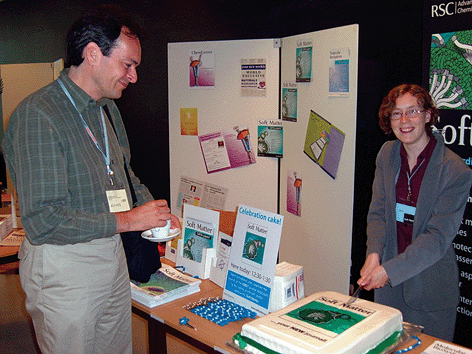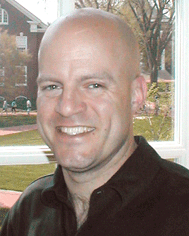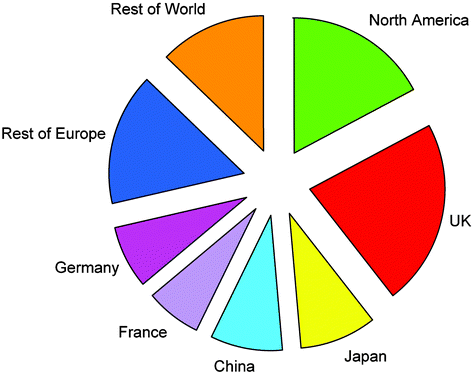Soft Matter: the essential ingredient for success
Abstract
In 2005, Soft Matter was launched, with much celebration and consumption of cake. Chairman of the Board Ulli Steiner and Editor Carol Stanier look back on the progress of Soft Matter in 2005 and look forward to new developments, such as RSS feeds and forward linking, in 2006.
At the 6th Liquid Matter conference in Utrecht, Soft Matter cake was devoured with great delight by members of the community (see Fig. 1). This voracious appetite is analogous to the enthusiasm with which the journal itself has been received at all meetings and by the community at large. The first issue of Soft Matter appeared in June 2005 and was the result of much careful preparation.
 | ||
| Fig. 1 Professor Alfons van Blaaderen (Utrecht) eagerly awaits the first piece of Soft Matter cake, being cut by Editor Carol Stanier. | ||
The driving force for the creation of Soft Matter came from the community, who called for an interdisciplinary home for their work to unify them, and give physicists, chemists, biologists, materials scientists, chemical engineers and food scientists a forum for discussion of their research. These scientists all make a big contribution in their roles as authors and referees; vital roles that define the flavour of a journal, i.e., its scope and quality. In its first six months, Soft Matter has published papers on topics as diverse as surface science, polymer brushes, biological ion channels, core–shell nanoparticles, flow of complex fluids and liquid crystals. We have worked hard to ensure that everything that reaches our broad and interdisciplinary audience is of the highest quality and interest and our referees have been instrumental in this task; on their recommendation we have rejected about half of all papers received. With your help we will continue to guarantee that Soft Matter brings only the best work to our gourmet readership. We are very grateful to the people who have given their valuable time to making Soft Matter a success.
Publishing in Soft Matter ensures your research will be noticed, and authors are an essential ingredient. Please send us your best papers in these topics: bulk soft matter assemblies, soft nanotechnology and self-assembly, biological aspects of soft matter, surfaces, interfaces, and interactions, building blocks/synthetic methodology, theory, modelling, and simulation. We will make certain that your work is read by those who need to read it by sending copies to the scientists you nominate as the most important audience for your work. In addition, several Soft Matter articles have been highlighted in our news supplements Chemical Science and Chemical Technology, as well as and on our website.
Soft Matter has had valuable input from our Editorial Board and International Editorial Advisory Board, which both consist of top scientists in their fields. All of our board members are dynamic and flexible enough to recognise the need for this new journal and have convinced others of this necessity. I would like to personally thank all the board and advisory board members for their enthusiasm and commitment since the very beginning. Our Editorial Board Members are deeply involved in the content and direction of the journal, and their appetite for this is reflected in the stimulating editorials they have provided for each issue of the journal. They have also shown support by publishing their best work with us—indeed this issue contains an excellent paper by Editorial Board Member Colin Bain on freezing transitions in mixed monolayers at the air–solution interface.1
Your response to our call for papers has been excellent, and the numbers of papers we have received in all topics have increased month on month—this shows that more and more people want a slice of the action. The opportunity to promote your work on the cover or inside front cover of Soft Matter has been very popular, with much competition for these top spots (see Fig. 2 for examples). We do encourage authors to send suggestions for covers with their manuscript. Authors who have their work featured on the covers receive hard copies of the cover and also the electronic file to use in presentations, etc. In addition the covers are promoted widely on our web pages including the Soft Matter home page, the contents pages, and the cover gallery—these stunning pictures are simply the icing on the cake!
 | ||
| Fig. 2 Covers from 2005 (a) Cover picture from Julian Eastoe and Ana Vesperinas (Issue 5); (b) inside front cover from David Quéré and Mathilde Callies (Issue 1). | ||
Darrin Pochan (Fig. 3), wrote a thought-provoking editorial2 about his plans for the Soft Matter Delaware (USA) Office. His office is now fully functional and he has been busy both handling manuscripts and representing Soft Matter at conferences. If you are based in the USA or Canada please do submit your papers to Darrin, using our online manuscript submission and tracking system at www.rsc.org/ReSourCe/.
 | ||
| Fig. 3 Professor Darrin Pochan in the Soft Matter North American Editorial Office. | ||
The Royal Society of Chemistry brings to the mix a great expertise in journals publishing. Speed is an important factor—while baking a cake requires time and patience, we understand that your research must be brought to its audience as fast as possible, and that is what we strive to achieve, with an average time to publication of around two months for original research. The RSC also provides innovation in publishing: 2005 has seen RSC Publishing invest significantly in technological developments across all of its products. First there was the introduction of the new website in the summer which included a contemporary, fresh look and an enhanced structure for improved and intuitive navigation between relevant, associated content. The improvements to the technological infrastructure have made the site more flexible and efficient, and equip the RSC to better deliver enhanced publishing products and services for its customers in the future. The new look was just the start and towards the end of the year we were pleased to provide further enhancements in the form of RSS feeds and ‘forward linking’ facilities.
RSS, or ‘really simple syndication’, is the latest way to keep up with the research published by the RSC. The new service provides subscribers with alerts as soon as an Advance Article is published in their journal of choice. Journal readers simply need to go to the journal homepage, click on the RSS link, and follow the step-by-step instructions to register for these enhanced alerts. RSS feeds include both the graphical abstract and text from a journal's contents page—i.e. they deliver access to new research straight to a readers PC, as soon as it is published!
‘Forward linking’, the reverse of reference linking, enables readers to link from any RSC published paper to the articles in which it is cited. In essence, it allows researchers to easily track the progression of a concept or discovery, since its original publication. With one click of a button (on the ‘search for citing articles’ link) a list of citing articles included in Cross-Ref is presented, complete with DOI links. At a time when research is becoming increasingly interdisciplinary in nature and the amount of published works continues to grow, the new technology, developed in conjunction with Cross-Ref, will significantly reduce the time spent by researchers searching for information.
There are developments in Soft Matter's host journals too: our online host Physical Chemistry Chemical Physics will be moving to weekly publication in 2006. PCCP publishes physical chemistry, chemical physics and biophysical chemistry and has recently seen its Impact Factor rise for the fourth successive year. The journal is renowned for having the fastest publication times in the field—twice as fast as the main competitors. “Weekly publication means we'll be able to bring you the latest research faster than ever” Susan Weatherby, Editor of PCCP, said. “With our rapid publication times and high quality content we are confident that we have a winning formula for physical chemistry.”
Soft Matter has turned out to be a delicious mixture of Reviews, Highlights, and Emerging Areas, for overviews of important topics, Opinions, and Communications and Full Papers for up-to-the-minute information on your field from all areas of soft matter and all corners of the globe. Interdisciplinarity can be seen in the broad range published, and many papers have received excellent feedback. International flavour is ensured by a good distribution of submissions from around the globe (see Fig. 4).
 | ||
| Fig. 4 Soft Matter has received submissions from across the world (information correct to November 2005). | ||
The feast will continue into 2006, with 12 issues of Soft Matter planned. Soft Matter willgrow and change in response to the requirements of the community it serves, but these essential ingredients will all remain to provide the distinctive flavour of Soft Matter.
Professor Ullrich Steiner
Chair,
Soft Matter Editorial Board
Dr Carol Stanier
Editor, Soft Matter
References
- C. Bain, L. Qunfang and K. M. Wilkinson, Soft Matter 10.1039/B511561B.
- D. Pochan, Soft Matter, 2005, 1, 176 RSC.
| This journal is © The Royal Society of Chemistry 2006 |
